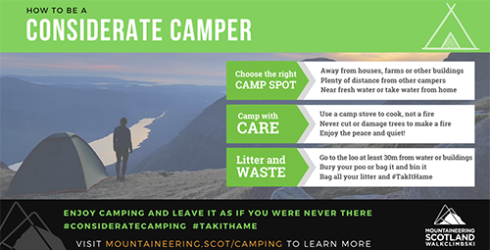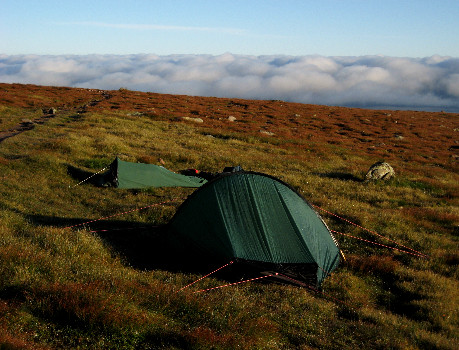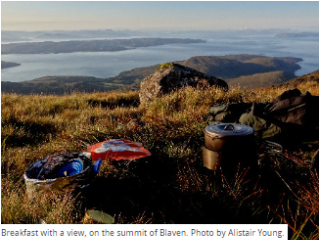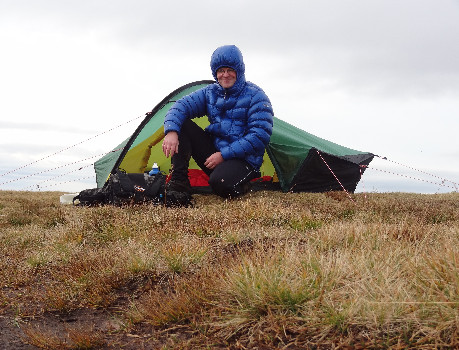
Whether itís an idyllic summer camp near the banks of a gently flowing burn, or the austere pleasure of a winterís night on the high tops, the rewards of properly wild camping are sufficient to tempt many away from commercial campsites.
Because the essence of wild camping is getting away from it all, itís important to make sure you get things right and take everything you need. If youíre wild camping miles from the nearest road you canít go to the campsite shop when you realise youíve forgotten the milk. And you canít just retreat to the car if your tent starts leaking, or if it collapses in a gale.
Wild camping also means not causing disturbance or problems for others. You should avoid camping enclosed fields, keep away from roads and buildings, and be careful not to disturb farming or other commercial activities. The emphasis of responsible wild camping should be on leaving no trace of your visit.
Be a considerate camper and think about the following:
It's a good idea to familiarise yourself with your tent if you haven't used it before. A windy hillside is not the place to try pitching a new tent for the first time. Practice until you are happy you can pitch it quickly and easily in most conditions.
Make sure your tent is suitable for the conditions you expect to face. Modern tents are good, but all are a compromise between price, weight and robustness. A super-lightweight tent thatís ideal for summer might be too cramped or lack the stability for a night in a full-on blizzard on the Cairngorm plateau.
Talk to someone experienced about what sort of tent you need, based on your intended use and budget; then start looking at the choices available. And remember as a member of Mountaineering Scotland you have access to discounts with many outdoor retailers as part of your member rewards.

Waking to a cloud inversion on Braeriach. Photo by Alistair Young.
In general youíll be looking for a flattish, sheltered spot of ground that will take a tent peg and that isnít too far from a source of fresh water. But thereís a lot to consider in choosing your pitch for the night, and a lot of that depends on the weather youíre expecting: that flat, grassy spot by the side of the burn might not be so attractive if heavy rain is forecast and the burn bursts its banks, and the endless vistas offered by the hilltop camp wonít be appreciated if the cloud is down and youíre too busy hanging onto a boulder in a hurricane!
So donít just think about the terrain, consider how the weather might change things, and in summer, consider whether your idyllic campsite will turn into a haven for the midges once the brightness of the day and the breeze begins to fail.
First priority, once youíve chosen your camping spot, is to get the tent up. Donít dither about and end up getting chilled, or wait for the light to go or the weather to take a turn for the worse Ė just get the tent up.
Youíll have sussed out water availability while choosing your spot so, once you have the tent pitched to your satisfaction, fill your water container and get everything arranged to suit. Itís a good idea to get your sleeping mat laid out and spread your sleeping bag on top to allow it to loft up for more warmth.


Fires are strongly discouraged for cooking especially in woodlands, on peaty soils and where thereís a lot of dry vegetation or other fire risk; they range between difficult and downright impossible in the rain, and you may find thereís no fuel in the area anyway.
The practical solution is a camping stove which is safer, cleaner and quicker. There are many different types and brands, just choose one that meets your needs and use it carefully Ė tents and the countryside both are very flammable. If you havenít camped before ask advice on how much fuel youíll need; itís good to carry a little extra so you don't run out.
Youíll need pots or mess tins too, or at least one pot to boil water, depending on your choice of food. With a little bit of planning you can easily prepare ďboil in the bagĒ food and use the hot water for soup or a brew. Or you may prefer to use dehydrated food which is lighter, but does require you to use the hot water youíve prepared, meaning more fuel is used.
Whether you make do with one pot for cooking in and eating out of, or whether you go for a more elaborate set with multiple pots and plates is a matter of taste (and weight), but do remember some cutlery, and a mug is better for drinks than sipping out of the pan.
Lightweight fold-away drinking bottles are also excellent as you can use them for your drink during the day and they double up for your evening brew, while Ďsporksí (a combination fork/spoon) provide a lightweight alternative to more traditional camp cutlery.

Cooking, washing up and drawing your drinking water in the great outdoors is very satisfying, and a big part of the enjoyment of wild camping. But remember that you are away from the controlled environment of your own kitchen and to be sure of avoiding stomach bugs you should follow some basic hygiene practice.
This is another item where you should think about the sort of camping you are going to be doing. Factors to consider are warmth, weight and bulk Ė along with the old down v man-made insulation argument.
You want a bag which you can get into your rucksack along with all your other kit, and which doesnít weigh too much. But you also need a bag which keeps you comfortably warm right through the night, so thatís a compromise you have to think about. Down gives more warmth for weight than artificial fibre, and also packs smaller, but it is more expensive and you have to be sure you can keep it dry, as sodden down offers very little insulation (although recent developments in Ďhydrophobicí down may change this).
In general, added warmth means added weight and bulk: donít skimp, but donít insist on a four season sleeping bag if youíre only going to be camping in the glens during the summer months. As with tents, seeking advice from someone experienced can help greatly as there is a lot of choice out there. There's an excellent article on the subject on UKClimbing about choosing a sleeping bag - click here to view.
And remember, whether the filling is down or man-made, keep it dry. Few rucksacks are waterproof, so make sure your sleeping bag is in a dry-bag or - at the very least - a polythene bag. Even on a warm night a wet sleeping bag is pretty miserable.
When the rain comes tipping down keeping the inside of your tent dry can become a major challenge. Good quality tents these days are unlikely to leak: the most likely cause of water getting inside the tent is you.
Chris Townsend has some good advice on keeping the inside of your tent dry in wet weather.
Thereís all sorts you can take on a camping trip, and some people will argue long and hard for their favourite pieces of kit being essential while others will just dismiss it as surplus weight. As a general rule, beyond tent and sleeping bag the necessities are:
Some take only the clothes they stand up in, others have at least one complete change of clothes. It really depends on personal preference and the weather you expect on a trip. If you get soaked through the day itís good to have dry clothes to change into in the evening. Like your sleeping bag, spare clothes should be kept in a dry-bag.
Remember, too, that you may be sitting around camp for some time, so an extra warm fleece or lightweight insulated synthetic jacket is handy for chilly evenings and mornings. If you take nothing else in the way of extra clothing, a spare warm layer and a dry pair of walking socks for your second day will definitely be worth their weight! Oh, and donít forget the hat and gloves, even though itís summer!

A warm jacket can make all the difference in the evening.
When you pack up and leave in the morning no-one should be able to tell that you were ever there. That means when you pitch your tent you choose your spot so that you donít have to disturb the ground or break down vegetation. Donít dig drainage ditches round your tent or ring it with stones.
Once youíve packed everything up have a good look over the site to check for stray tent pegs or small bits of gear. Above all, donít leave any rubbish or food waste. Plan for rubbish before you start: no-one wants used food wrappers messing everything up, so make sure you have a sealable bag to carry rubbish like this.

If you have had a campfire Ė and itís usually best not to Ė then you need to take especial care to make sure it is properly extinguished and that all traces of it are erased. Where thereís high organic content in the soil Ė such as peaty areas Ė a fire may smoulder undetected in the ground itself, flaring up even days later to start a forest or heath fire. Even with the fire out you should still scatter the ashes and made sure you have not left a burnt circle on the ground.
Avoid causing pollution by urinating at least 30 m away from open water/rivers/streams and burying solid waste as far as possible from open water/rivers/streams and buildings. Used toilet paper should be carried out and disposed of appropriately on your return to base. Remember to pack a lightweight trowel and carry enough toilet paper (with resealable bags for when itís been used) and some suitable hand sanitizer gel.
In winter, donít just dig a hole in the snow, because when the snow melts your solid waste will still be there, unsightly and polluting. If you cannot bury solid waste in the ground it should be carried out in a designated container and disposed of appropriately.


Mountaineering Scotland campaigns on behalf of Scotland's hill walkers, climbers, mountaineers and ski tourers, with over 16,000 members from all walks of life.
Membership of Mountaineering Scotland supports the work we do, from campaigning and protecting mountain landscapes and access, to promoting skills, responsible access and self-reliance for those who visit Scotland's hills, crags and climbing walls.
Membership is excellent value at less than £3 a month for adults, and includes public and civil liability insurance, a range of member discounts and offers, access to great value mountain skills courses, Scottish Mountaineer magazine and more. Read more about our membership benefits.